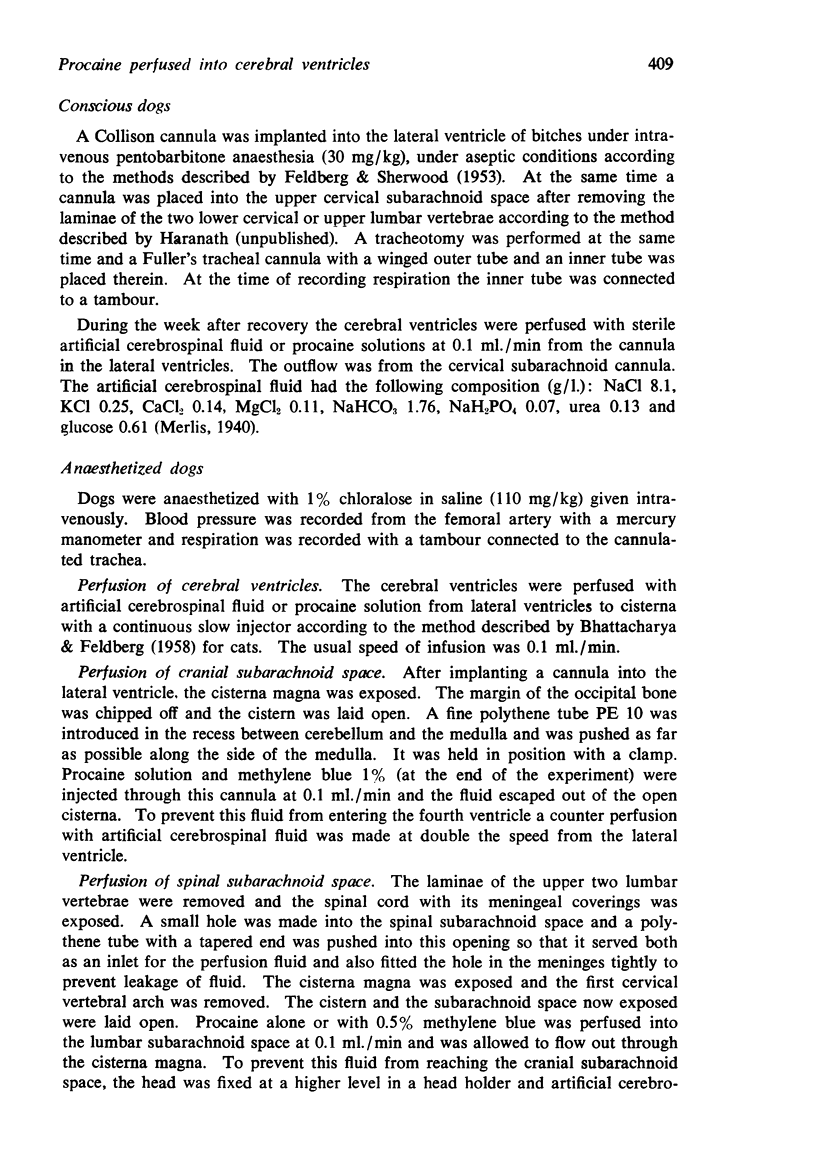Abstract
1. Perfusion of 1% procaine into the cerebral ventricles of conscious dogs produced mild paresis, defaecation, vomiting, jerky movements of eyelids, brisk nystagmus, increase in amplitude of respiration and sometimes loss of consciousness. Procaine 2% produced paralysis, loss of consciousness and sometimes respiratory depression.
2. Procaine 2% perfused into the cerebral ventricles of dogs under chloralose anaesthesia produced an initial increase in amplitude of respiration, which preceded its final depression, which is due primarily to procaine and only partly to a change in pH.
3. The site of action for the initial increase in amplitude of respiration was in the fourth ventricle, for it did not occur on perfusion of procaine into the cranial subarachnoid space.
4. Perfusion of spinal subarachnoid space with procaine is enough to cause respiratory failure even when the procaine does not reach the medulla.
Full text
PDF








Selected References
These references are in PubMed. This may not be the complete list of references from this article.
- BHATTACHARYA B. K., FELDBERG W. Perfusion of cerebral ventricles: effects of drugs on outflow from the cisterna and the aqueduct. Br J Pharmacol Chemother. 1958 Jun;13(2):156–162. doi: 10.1111/j.1476-5381.1958.tb00211.x. [DOI] [PMC free article] [PubMed] [Google Scholar]
- HARANATH P. S., AYESHABEGUM N., SITARAMAYYA G. V. THE EFFECTS OF PROCAINE INJECTED INTO THE CEREBRAL VENTRICLES OF CONSCIOUS AND ANAESTHETIZED DOGS. Br J Pharmacol Chemother. 1965 Apr;24:339–347. doi: 10.1111/j.1476-5381.1965.tb01720.x. [DOI] [PMC free article] [PubMed] [Google Scholar]
- Haranath P. S., Bhatt H. V. Studies on cinchocaine and lidocaine administered into cerebral ventricles of conscious and anaesthetized dogs. Indian J Med Res. 1968 Feb;56(2):217–226. [PubMed] [Google Scholar]
- LOESCHCKE H. H., KOEPCHEN H. P. Beeinflussung von Atmung und Vasomotorik durch Einbringen von Novocain in die Liquorräume. Pflugers Arch. 1958;266(6):611–627. doi: 10.1007/BF00363038. [DOI] [PubMed] [Google Scholar]
- LOESCHCKE H. H., KOEPCHEN H. P., GERTZ K. H. Uber den Einfluss von Wasserstoffionenkonzentration und CO2-Druck im Liquor cerebrospinalis auf die Atmung. Pflugers Arch. 1958;266(6):569–585. doi: 10.1007/BF00363036. [DOI] [PubMed] [Google Scholar]
- LOESCHCKE H. H., KOEPCHEN H. P. Versuche zur Lokalisation des Angriffsortes der Atmung- und Kreislaufwirkung von Novocain im Liquor cerebrospinalis. Pflugers Arch. 1958;266(6):628–641. doi: 10.1007/BF00363039. [DOI] [PubMed] [Google Scholar]
- SEVERINGHAUS J. W., MITCHELL R. A., RICHARDSON B. W., SINGER M. M. RESPIRATORY CONTROL AT HIGH ALTITUDE SUGGESTING ACTIVE TRANSPORT REGULATION OF CSF PH. J Appl Physiol. 1963 Nov;18:1155–1166. doi: 10.1152/jappl.1963.18.6.1155. [DOI] [PubMed] [Google Scholar]


